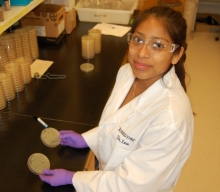
Major:
Mentor(s):
Faculty Sponsor(s):
Faculty Sponsor's Department(s):
Project Title:
Project Description:
Bacteria engage in communal behavior, capable of communicating among the colony. One example of such interactions is contact-dependent growth inhibition (CDI), whereby bacteria touch neighboring, competing cells and inhibit their growth. It is known that CDI is mediated by large, cell surface proteins bearing toxic tips. These tips are auto-cleaved upon contact with cell surface receptors on the neighboring cell. The focus of this work is to determine which genes are up- or down-regulated in genetically identical cells capable of engaging in CDI. The lacZ gene was randomly inserted into the E. coli K12 chromosome, lacking CDI and LacZ genes, and fused to virtually every gene therein. Then we introduced a CDI plasmid under IPTG control into the cells. The screen for CDI gene regulation was composed of compounds X-gal and IPTG in growth media. X-gal is cleaved by the lacZ product, β-galactosidase, and causes blue coloration in bacteria, while IPTG is a lac operon inducer and turns on CDI expression. LacZ expression between cells with and without IPTG is distinguishable by the blue coloration, identifying cells where gene regulation is altered by the CDI system. This work would be the first in which bacteria have been shown to communicate via CDI. These studies are directly relevant to understanding how bacteria interact with one another in the real world, for example in the human intestinal microbiome. Further, these results could be applied to the development of drugs that block communication between pathogens, or enhance communication and growth between beneficial strains.
